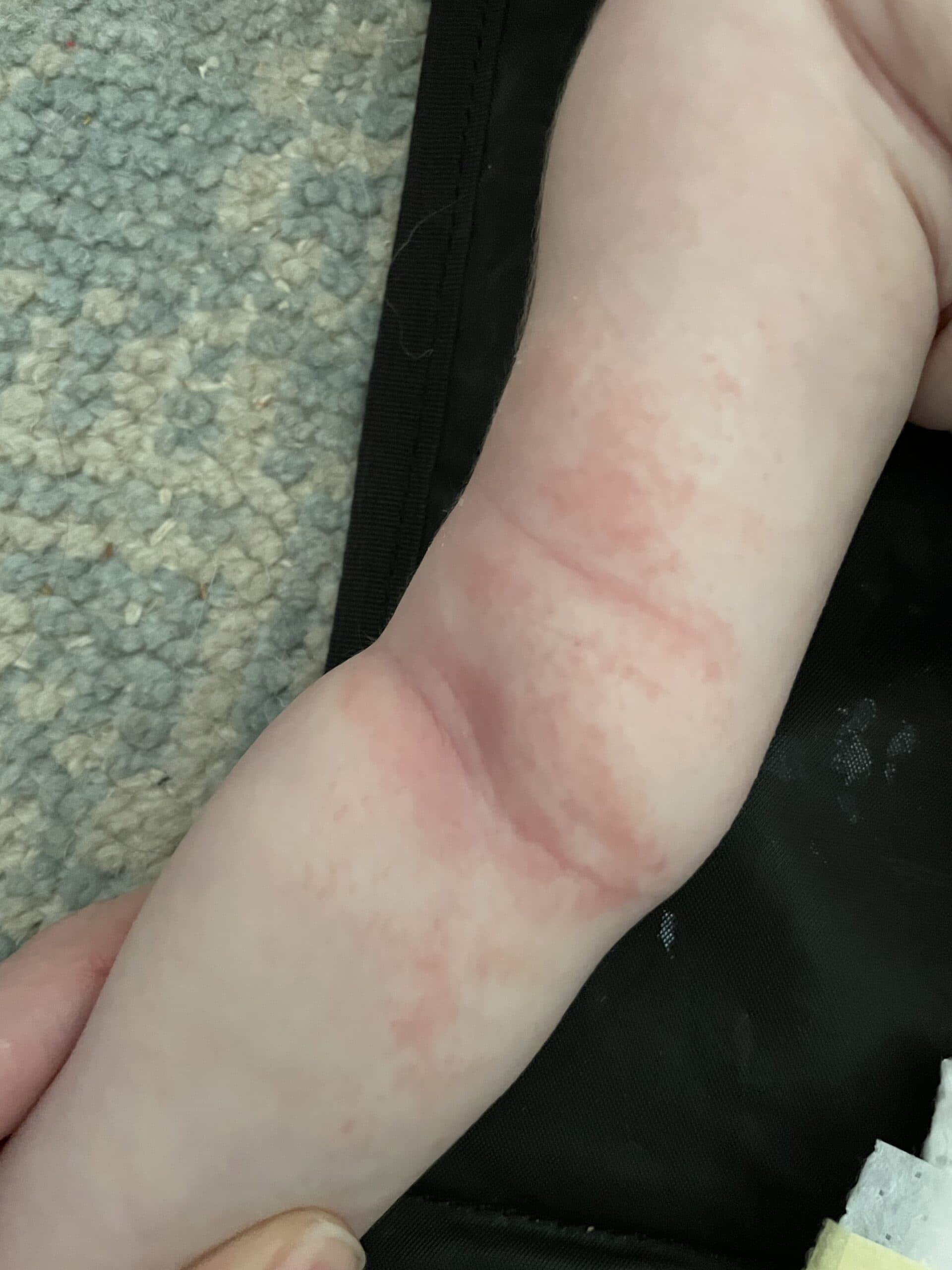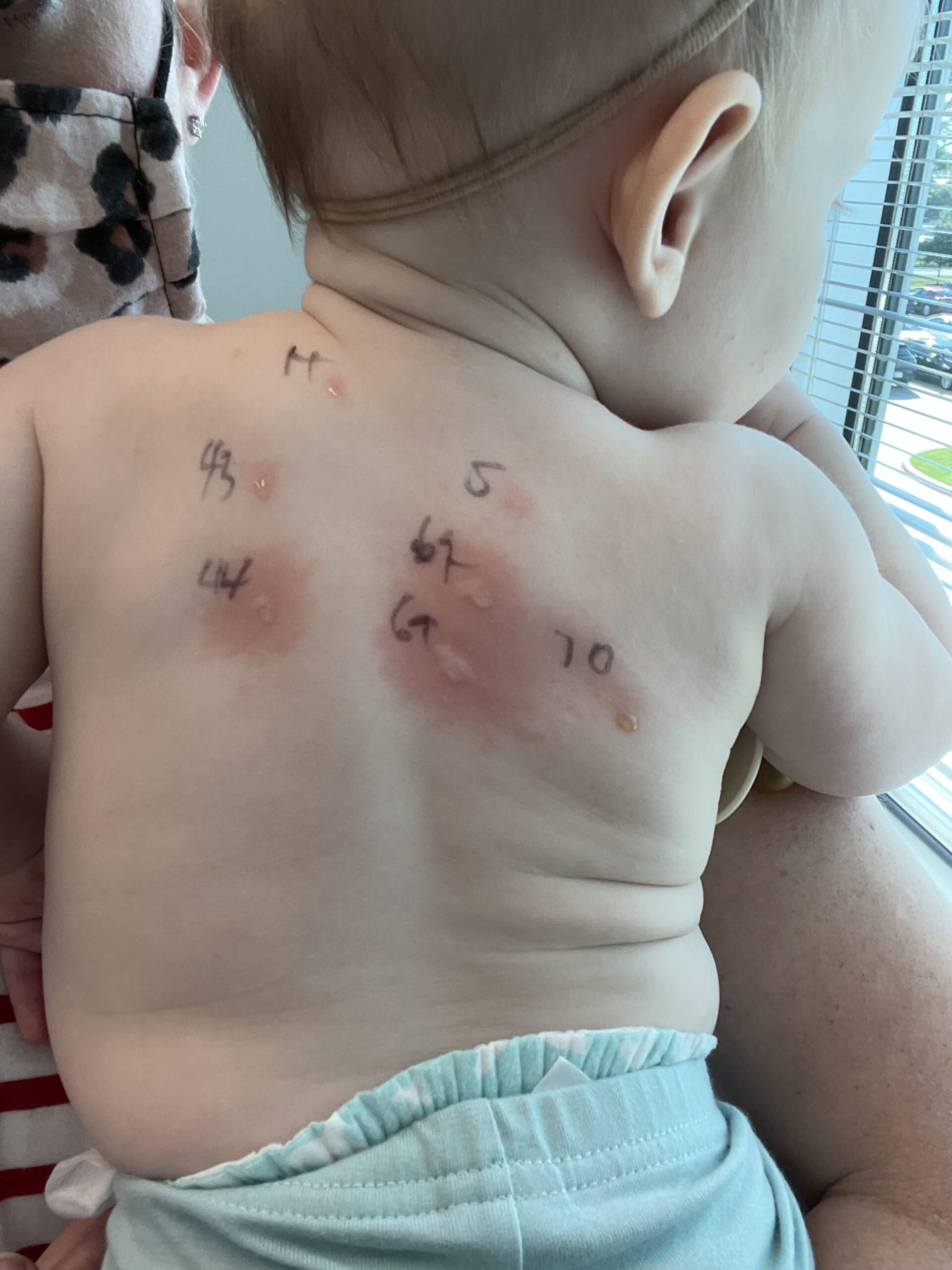Before I had children of my own, I worked in a pediatric food allergy clinic. Then, when I had babies, they both had milk allergies! It was overwhelming to receive a milk allergy diagnosis for my girls. Fortunately, I could recognize the symptoms of dairy allergy in my breastfed babies because of my work experience, and I know how to read food labels to avoid accidentally eating dairy or feeding it to them. So, if you have questions about or suspect a milk allergy in your baby, you’ve come to the right place! Here, we’ll dive into the types, symptoms, causes, diagnosis, and treatment of a milk allergy in babies.
A milk allergy happens when the body reacts poorly to the exposure of milk from cows or other mammals, such as sheep, goats, or buffalo.1 The technical term for a milk allergy is cow’s milk protein allergy (CMPA).7 Most of the time, these reactions happen from eating or drinking the milk, but in rare cases, breathing in milk particles or touching milk products can also cause an allergic reaction.2
Types of Milk Allergies and Their Symptoms
There are different types of milk allergies caused by different types of immune cell reactions and body systems. Symptoms of milk allergy can vary depending on the type of allergy.1 Here are two types of true milk allergies classified by the type of immune response causing the reaction:
One type of milk allergy is an IgE-mediated allergy, which is named for the type of immune reaction. IgE-mediated allergies typically cause more immediate reactions in the body after consuming milk. This type can cause anaphylaxis, which is a serious reaction involving symptoms like swelling of the throat and breathing difficulties.2 An IgE-mediated milk allergy can affect the skin, gut, and/or respiratory systems. Symptoms of milk allergy include:3
- Rash, itching, hives, and swelling
- Nausea, vomiting, diarrhea, and abdominal pain
- Sneezing, congestion, itchy or runny nose, coughing, wheezing, and shortness of breath

There’s also another type that isn’t mediated by IgE antibodies. This non-IgE-mediated milk allergy involves a different part of the immune system that reacts when exposed to milk. Like IgE-mediated allergies, non-IgE-mediated milk allergies can also affect the skin and gut. They may cause symptoms like itching and eczema, abdominal pain, colic, and mucus or blood in the stool.3
While symptoms of both types can be similar, non-IgE mediated milk allergies typically cause a delayed reaction up to 48 hours after consuming milk, and they don’t cause respiratory symptoms or anaphylaxis.3
In addition to the two different types of milk allergies discussed above, there’s also a third type of reaction called lactose intolerance. People often confuse milk allergies with lactose intolerance, but it’s a different reaction to milk.3 While a true milk allergy is an adverse immune system reaction to the casein and whey proteins in milk, lactose intolerance is not an immune reaction. It’s a localized reaction in the intestines to the sugar (lactose) in milk. Lactose is a large sugar molecule present in all mammalian milk, meaning that even breast milk has lactose.3 An enzyme in the gut called lactase breaks down lactose into sugars that can be more easily digested and absorbed. The lactose in breast milk provides a significant amount of daily calories and energy to breastfed babies.4
Symptoms of lactose intolerance include bloating, gas, diarrhea, and abdominal pain.3 Lactose intolerance doesn’t appear in children under the age of 5, except for temporarily. An illness or infection such as a stomach virus can temporarily decrease the lactase enzyme count in the intestines, causing short-term lactose intolerance. Once the child heals, their lactase will return, and they’ll be able to digest lactose again.4
Breastfed infants affected by temporary (or “secondary”) lactose intolerance should continue breastfeeding, and formula-fed infants can try a lactose-free formula temporarily.4 The lactase enzyme naturally and gradually declines as children age and wean from breast milk, causing gastrointestinal symptoms with significant milk consumption in older children, teens, and young adults.4
While decreased lactase in the intestines causes lactose intolerance, a true milk allergy happens when the immune system falsely identifies milk protein as a threat. It attacks the milk protein with a chemical called histamine, which triggers the typical allergic symptoms like itching, sneezing, and diarrhea.1
There’s also a genetic component to this allergy. According to one study, infants with a milk allergy were much more likely to have first-degree relatives with other atopic conditions such as eczema, asthma, and allergy.5 Anecdotally, both of my daughters had a non-IgE mediated milk allergy, and my husband has asthma and other environmental allergies. I highly doubt that’s pure coincidence!
Sometimes, symptoms alone are enough to diagnose a milk allergy. However, the diagnostic process may vary depending on your child’s symptoms and the type of milk allergy you suspect. If the cause of an allergic reaction is unclear or you or your doctor suspect a milk allergy in your baby based on skin, tummy, or breathing symptoms, they’ll likely want to perform some tests. They can diagnose IgE-mediated allergies (remember, these are the immediate-reaction allergies with skin, respiratory, and stomach symptoms) with the following:3,6

When I was a food allergy nurse, I performed skin prick tests on patients in our clinic. A small amount of milk protein is scratched onto the surface of the skin, usually on the back of a small baby, or on the forearm of a larger baby or child. After letting it sit for 15 minutes, we observe and measure the skin reaction to the milk protein. If it looks like a large hive or a bug bite, this may indicate a milk allergy.
Your baby’s blood can also be drawn and analyzed for the presence of IgE (Immunoglobulin E) in milk. If the IgE is above a certain value, your baby is likely allergic to milk. However, these cutoffs aren’t exact.3 The only definitive way to diagnose this allergy is through an oral food challenge.6
As a food allergy nurse, I used to administer oral food challenges under the supervision of doctors in a clinic or hospital. We would feed a child tiny, gradually increasing doses of milk while monitoring for signs and symptoms of an allergic reaction. If no symptoms appeared, we would proceed to the next dose. If the child passed the challenge, they weren’t allergic to milk and would receive instructions from the doctor on how to safely introduce the food into their diet. And if allergic symptoms occurred, we would treat the allergic reaction with an antihistamine or epinephrine and consider the child allergic.
Oral food challenges can also be used to diagnose non-IgE-mediated milk allergies, but this is more difficult because the reactions are often delayed.6 Non-IgE milk allergies can be diagnosed anecdotally and by checking for blood in the stool.6
My daughters both had non-IgE-mediated milk allergies as infants. Each of their main symptoms was blood in their stool. I started to notice that if I consumed a large amount of dairy and then breastfed them, their symptoms got worse. Our pediatrician tested their diapers for the presence of blood, though I could see it even without the test. These two factors combined made our pediatrician suspect a milk allergy. I eliminated dairy from my diet and continued to breastfeed, and their symptoms resolved. This is an example of an exclusion diet.3
If your child has a milk allergy, the safest way to prevent an allergic reaction is to completely avoid consuming any type of milk or milk product. In addition to avoiding milk, you must be prepared if your child consumes milk accidentally. Finally, you need to determine what alternative formulas and diets will work for them. Let’s explore these treatment options further:
To avoid consuming milk or feeding it to your milk-allergic child, be sure to read all food labels for allergen statements that a product contains milk. Look for ingredients such as:1
- Milk
- Cheese
- Butter
- Casein
- Whey
- Yogurt
- Cream
If your child receives a milk allergy diagnosis, the doctor will prescribe medications with instructions to administer them if your child consumes milk accidentally. If accidental ingestion happens, you should monitor for signs of a reaction and administer antihistamines, epinephrine, steroids, or anti-vomiting medications per your doctor’s orders. You should also go to the emergency room.7
If the mother of a milk-allergic baby is breastfeeding, she may also need to avoid all sources of milk in her diet, as these proteins can sometimes pass through the breastmilk to her allergic infant.6 I went dairy-free for about the first nine months of each of my daughters’ lives because they were allergic to milk and I was breastfeeding.
If your formula-fed baby needs to avoid milk, there are different types of hypoallergenic or dairy-free formulas:
In a hydrolyzed formula, the milk proteins casein and whey are broken down extensively and typically don’t cause a reaction. Most infants who are allergic to milk can tolerate hydrolyzed formula.1,3
If your baby is still having allergic reactions to hydrolyzed formula, your doctor may recommend trying an elemental or amino acid-based formula. This is one in which the proteins are completely broken down and unrecognizable as milk protein. Amino acid formulas should be a “last resort” if your baby isn’t tolerating extensively hydrolyzed formula.3
Soy formula is also available, and some people wonder about it as a substitute for milk-based formulas. Babies under 6 months typically shouldn’t have it because it has similar effects to estrogen. Also, many babies who are allergic to milk are also allergic to soy.3 This was true for my girls — in addition to avoiding all dairy, we avoided all soy, including edamame, tofu, miso, soy lecithin, and more. Soy formula must also be fortified to be nutritionally complete for an infant.1
It can be overwhelming to receive a milk allergy diagnosis and have to overhaul your or your child’s diet completely. Fortunately, this allergy doesn’t always last forever. In fact, most babies outgrow their milk allergy during childhood.1,2 But until a child has outgrown their milk allergy, they should avoid consuming milk completely. A baby with a diagnosed milk allergy should avoid milk entirely for at least six months. After that time (depending on lab values, symptoms, and other considerations), your doctor may consider the gradual reintroduction of milk into the diet.3
Some new therapies are under investigation to help children outgrow their milk allergies. Oral immunotherapy involves feeding a child a tiny amount of milk daily and gradually increasing the dose. This isn’t FDA-approved and is currently only done in research studies under the close supervision of a medical team.7
Sometimes, a child can tolerate milk when baked into food items such as a muffin, even if they can’t eat or drink milk directly. Your doctor may recommend a supervised food challenge of baked milk to see if your baby can tolerate heated milk before gradually increasing the volume of baked milk and decreasing the degree to which it’s baked.3 The theory is that these small exposures to milk over time help desensitize your child’s immune system to milk and help them outgrow their allergy. However, you should only do this with the help of your pediatrician or allergist. It’s also important to note that these therapies require keeping milk in the diet regularly — you can’t stop feeding your child milk for a while and then pick up where you left off.7
A suspected or confirmed milk allergy in babies can feel scary and overwhelming. Talk to your doctor about your concerns, and they’ll advise the best testing to determine the type of allergy, causes, diagnosis, and treatment. Hopefully, with time and patience, your baby will outgrow their milk allergy just like mine did!
